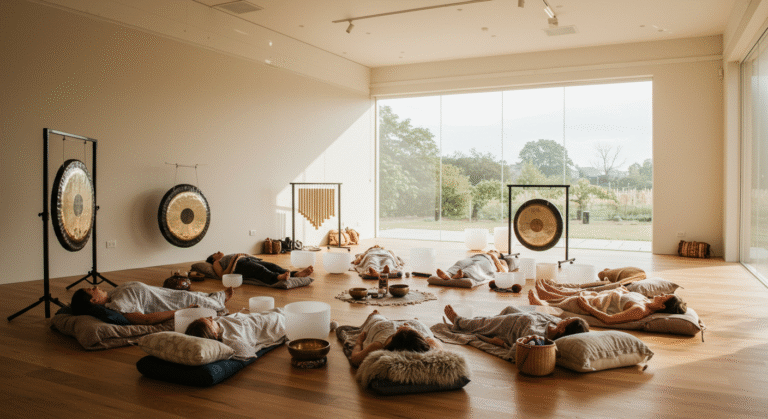Brown noise, often described as a deeper and richer sound than white noise, is gaining popularity for its calming and focusing effects. Whether you’re seeking to enhance concentration, improve sleep, or calm a restless mind, understanding the noise and its potential benefits can help you use this sound effectively.
What is it?
Brown noise, also known as Brownian noise or red noise, is a type of sound characterized by a low-frequency, rumbling tone that is deeper and more soothing than white noise. It gets its name from Brownian motion, a concept in physics that describes random, natural movements, such as the motion of particles in a fluid.
Unlike white noise, which contains equal energy across all frequencies, this noise has higher energy at lower frequencies, resulting in a deeper and more muffled sound—similar to a waterfall, thunder, or the distant hum of a storm.
Examples:
- Low, rumbling thunder
- Strong ocean waves crashing on the shore
- The hum of heavy wind
Brown Noise vs. White Noise vs. Pink Noise
1. White Noise:
- Contains equal energy across all frequencies, creating a static-like sound (e.g., a TV with no signal).
- Often used to mask environmental noises and promote sleep.
2. Pink Noise:
- A balance between high and low frequencies, softer than white noise but not as deep as (e.g., gentle rainfall or rustling leaves).
- Linked to improved memory and sleep quality.
3. Brown Noise:
- Deeper and richer, with more emphasis on low frequencies.
- Known for its ability to induce relaxation and focus.
Potential Benefits
1. Enhanced Focus and Concentration:
Many people report that it helps them concentrate, particularly those with ADHD or difficulty focusing in noisy environments. The low, consistent sound can mask distractions and create a calming background that promotes deep work.
2. Improved Sleep Quality:
- It can help people fall asleep faster by masking disruptive noises such as traffic, barking dogs, or household sounds.
- Its deeper tones may be especially soothing for those who find white noise too high-pitched or jarring.
3. Anxiety and Stress Reduction:
- The consistent and low-frequency sound of brown noise can help reduce anxiety by creating a stable, comforting environment.
- It may stimulate the parasympathetic nervous system, promoting relaxation and calming overactive thoughts.
4. Tinnitus Relief:
- Some individuals with tinnitus (ringing in the ears) find that brown noise provides relief by masking the internal noise, making it less noticeable.
5. Improved Cognitive Performance:
- Research suggests that continuous, low-frequency noise may enhance memory retention and cognitive functioning during tasks requiring sustained attention.
How to Use Brown Noise
1. For Studying or Working:
- Play brown noise through headphones or speakers at a comfortable volume to block distractions and maintain concentration.
- Use apps, websites, or devices specifically designed to generate brown noise.
2. For Sleeping:
- Incorporate brown noise into your bedtime routine by playing it softly in the background.
- Use sound machines or mobile apps that offer brown noise as part of their sleep programs.
3. For Anxiety or Meditation:
- Pair brown noise with mindfulness exercises or deep breathing to enhance relaxation.
- Try listening to it during meditation or when you need a break from overwhelming thoughts.
4. For Tinnitus Relief:
- Experiment with different volumes and frequencies to find the most effective combination for masking tinnitus symptoms.
Popular Apps and Tools for Listening to Brown Noise
- Noisli: Offers customizable soundscapes, including brown noise for focus or relaxation.
- Calm: A well-known meditation app with ambient sounds, including brown noise options.
- myNoise: Provides a wide range of customizable soundscapes.
- Sound Machines: Many sound machines feature brown noise as part of their sleep or relaxation settings.
Scientific Insights: What Does Research Say About Brown Noise?
While research on brown noise specifically is limited, studies on background noise and its effects on the brain suggest that:
- Consistent low-frequency noise can improve focus and cognitive performance, particularly for tasks requiring sustained attention.
- White and brown noise have been shown to aid individuals with ADHD by improving concentration and reducing external distractions.
- Low-frequency sounds are often linked to relaxation, with some studies suggesting they help activate the body’s natural calming mechanisms.
Who Can Benefit from Brown Noise?
- Students and Professionals: Those seeking improved concentration while studying or working.
- Individuals with ADHD: It may help minimize distractions and improve task completion.
- Light Sleepers: Those struggling to sleep due to environmental noises.
- People with Anxiety: The calming effect of the noise can help reduce stress and anxious thoughts.
- Individuals with Tinnitus: Those looking for relief from persistent ringing or buzzing in their ears.
Are There Any Drawbacks?
- Hearing Sensitivity: Some people may find it too deep or overwhelming.
- Prolonged Exposure: Listening to any noise at high volumes for extended periods may cause hearing damage.
Tip: Always play it at a safe volume, and take regular breaks if using it for long periods.
Final Thoughts: Is It Right for You?
Brown noise offers a range of benefits, from enhancing focus to promoting restful sleep and reducing anxiety. Whether you’re a student needing a productivity boost or someone seeking relaxation at bedtime, incorporating it into your daily routine could be a game-changer.
Give it a try and discover how this deep, soothing sound can positively impact your life.
For more insights on managing focus and well-being, subscribe to our newsletter and visit adhdtribe.co.uk.







